Traditional Frikadellen (German Meatballs)
This post may contain affiliate links. See my disclosure policy.
An authentic Frikadellen recipe, these beloved seasoned German meat patties are also popular in Denmark where they’re known as Frikadeller. They are extremely popular for both mealtimes and picnics because they’re equally delicious either hot or cold! They’ve been a household staple for centuries and their popularity has spread across multiple European countries and beyond!
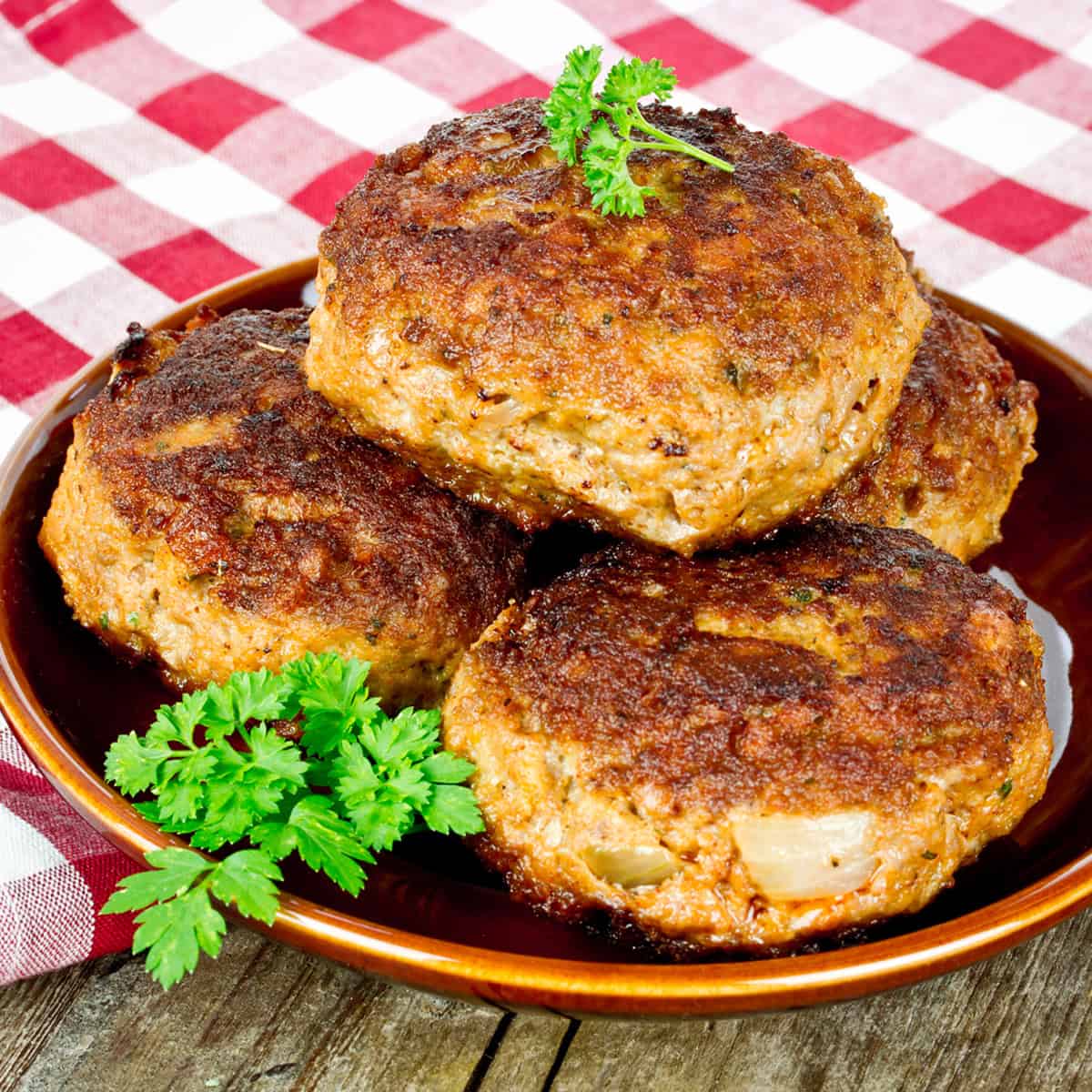
German Hamburgers
Frikadellen, as they’re called in Germany (aka Fleischküchle, Fleischpflanzerl and Buletten), or Frikadeller, as they’re called in Denmark, are seasoned meat patties – you could call them German hamburgers – that are equally good hot or cold and have been popular for both mealtimes and picnics for centuries. This authentic frikadeller recipe captures all the flavor of this popular European favorite!
Where did They Originate?
It’s origin is uncertain but it’s largely attributed to north Germany and Denmark though they have also become very popular throughout Scandinavia, Holland, Poland and other parts of the world. They can be traced back to at least the 18th century in Germany, though they’re almost certainly much older.
Who Invented Hamburgers?
While the the origin of the Frikadelle isn’t entirely clear, what we do know is that the Frikadellen of north Germany, of Hamburg specifically, were the inspiration for what became known as Hamburgers. That’s right, German immigrants from Hamburg took their Frikadellen with them to the United States, eventually someone threw a Frikadelle in between two buns and voilà, the rest is history!
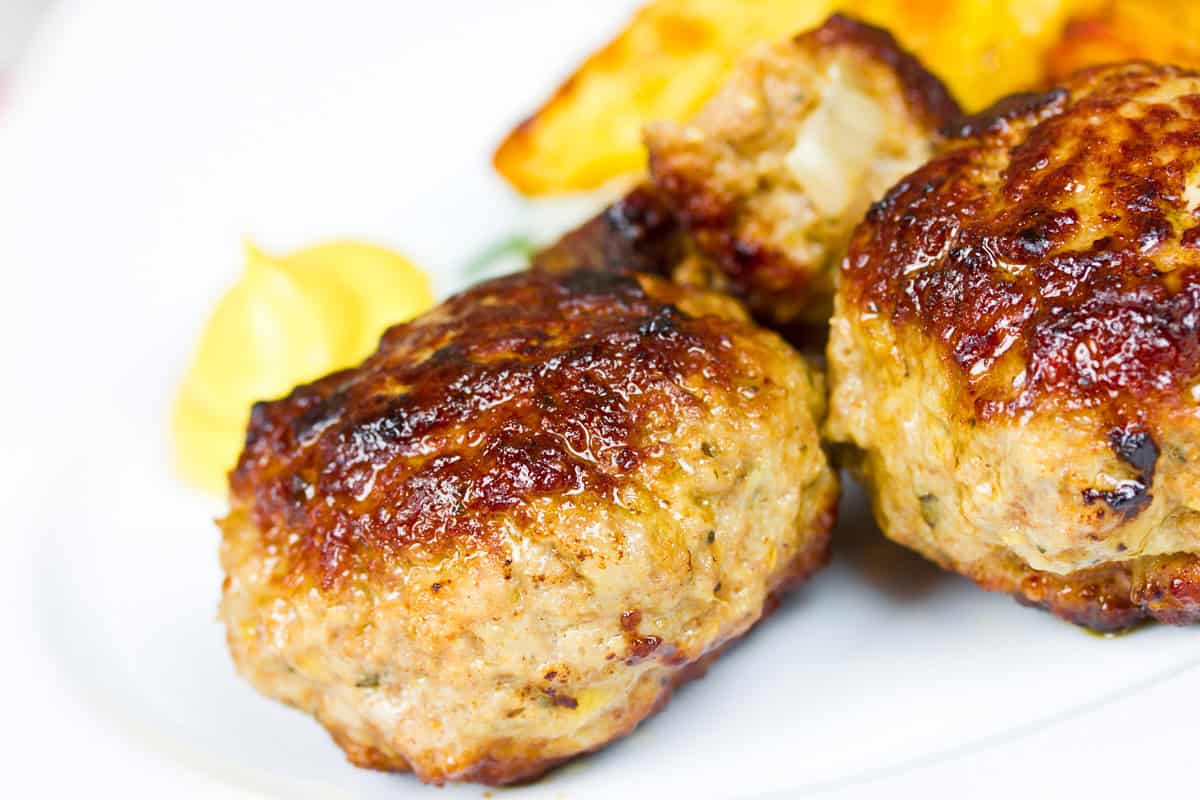
Frikadellen Ingredients
As with almost any “traditional” or “authentic” recipe, there is more than one version. Variations abound depending on the particular region and the particular family tradition. Nevertheless, Frikadellen and Frikadeller generally all have the same core ingredients in common: Ground meat, onions, bread, egg and seasonings. The regional differences vary in the specific seasonings.
In a collection of recipes compiled in 1790 by the mother of German author Theodor Fontanes, the over 200 year-old recipe for Frikadellen was largely the same then as it is today, incorporating ground meat (usually a combination of beef and pork), onions, bread, eggs, parsley and spices. The 1790 recipe calls for two very traditional spices, mace and cardamom. While nutmeg can be substituted, we recommend mace for that traditional old-fashioned German flavor. Likewise marjoram, not oregano, is the traditional herb of choice in Germany and Denmark and really contributes to an authentic flavor.
Traditionally Frikadellen were fried in pork fat or beef fat but today they’re most commonly fried in clarified butter (Butterschmalz) or oil or a combination of both.
Flavor Variations
If you’d like to change up the flavors for something different you can try swapping out the spices in this recipe for any of the following: Curry, chili powder, sun-dried tomatoes, preserved lemon (for a little Moroccan influence, harissa, caraway seeds, fennel, basil, thyme, rosemary, etc. Another variation is to make smaller Frikadellen and skew them onto kabob skewers.
Tips for Achieving the Perfect Frikadellen
- Select ground meat with a good ratio of fat. Do not use extra lean or the Frikadellen will lose a lot of water during cooking and become dry.
- When you press down the balls of meat be sure the width is even throughout the patty for even cooking.
- Moistening your hands with a little water before forming the patties will prevent the meat mixture from sticking to your hands.
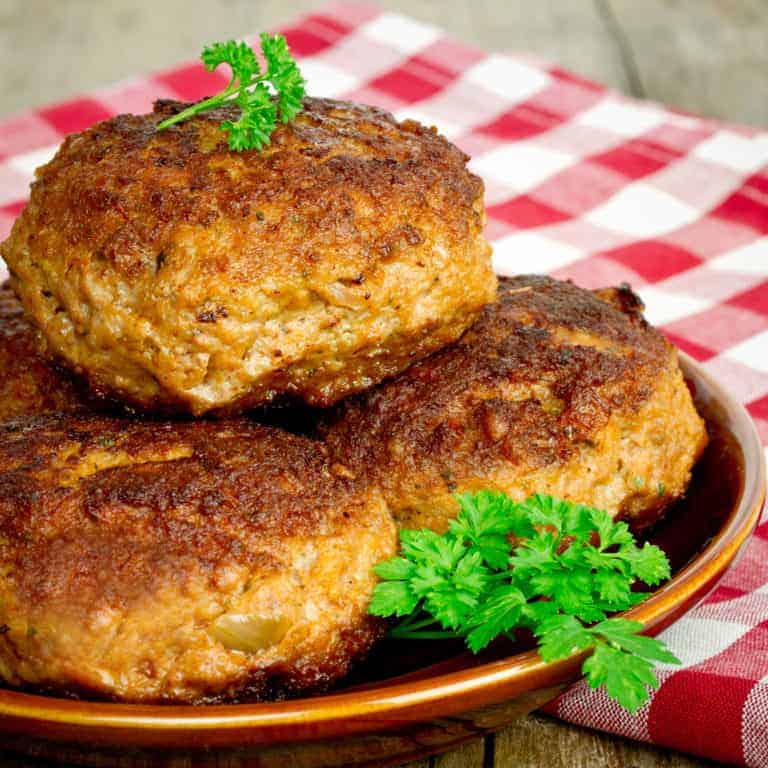
Frikadellen Recipe
Let’s get started!
Break the bread up into small pieces, place them in a small bowl and pour water/milk over them and let them soak for 15 minutes while you’re preparing the other ingredients. Squeeze out any excess liquid.
Heat some oil or butter in a frying and saute the onions until soft and translucent, 5-7 minutes. Add the garlic and cook for another minute.
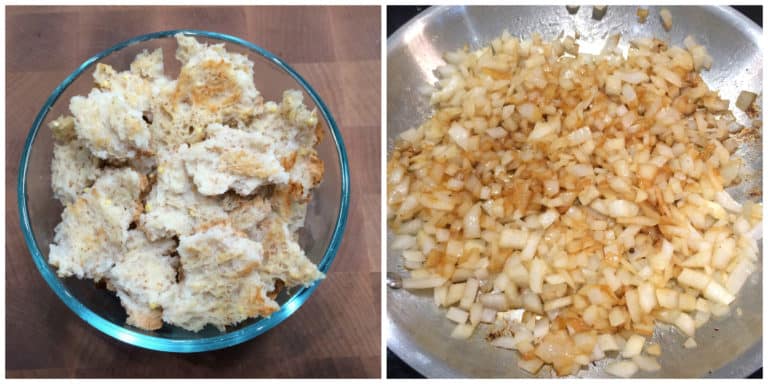
Place all of the ingredients (except for the olive oil and butter) in a large bowl along with the onion mixture and the soaked bread. Use your hands to thoroughly knead the mixture until well blended and the meat is smooth. The more you knead it, the better the results.
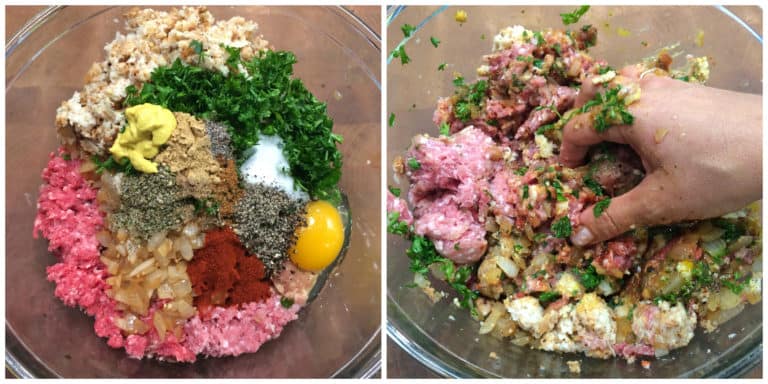
Form the meat mixture into balls according to desired size and slightly flatten them. Cover and chill the patties in the fridge for at least 30 minutes before frying them.
Heat the olive oil and butter in a frying pan. Once hot add the Frikadellen / Frikadeller and fry on both sides on higher heat until nicely browned, then lower the heat and continue to fry over medium heat until cooked through according to desired doneness.
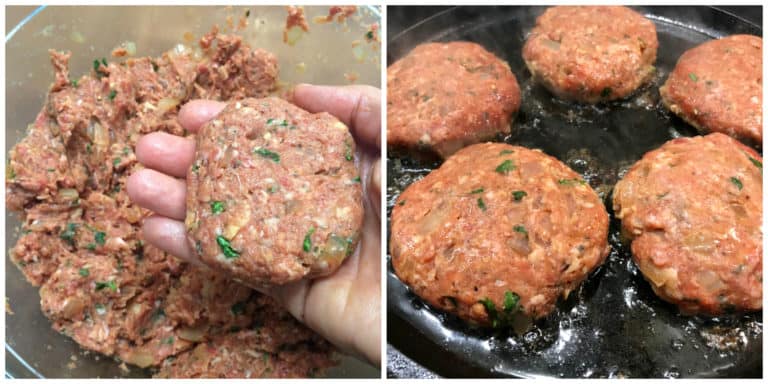
Frikadellen can be enjoyed both hot or cold. To store them let them cool completely and transfer them to an airtight container in the fridge. They can be reheated in the microwave.
Traditionally served with potato salad or a crusty bread roll slathered with mustard.
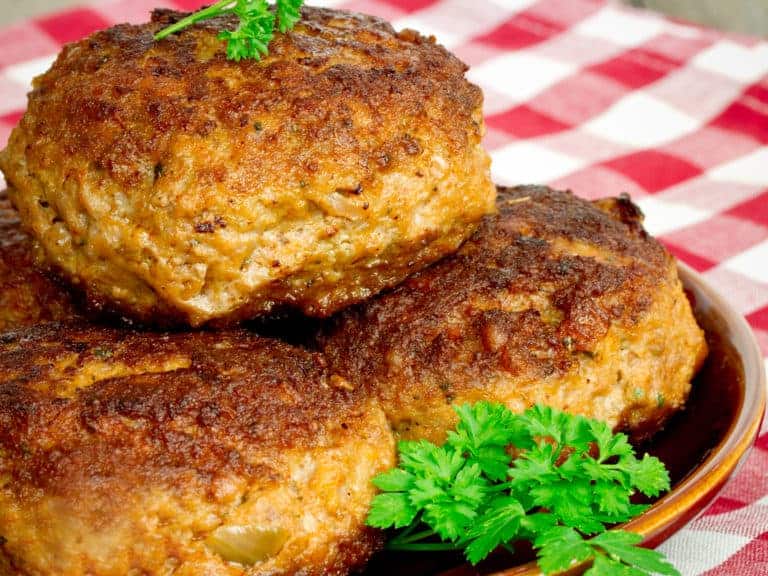
Can Frikadeller Be Made In Advance?
Yes! You can make the meat mixture at least one full day in advance. In fact we recommend it because the flavor only gets better. Cover and refrigerate the meat mixture and then make and fry the patties when you’re ready to use them. Or you can also form the patties in advance and keep them covered and chilled until ready to use. Frikadellen can be eaten hot or cold. They can be reheated in the microwave.
Do They Freeze Well?
Yes they do! They freeze really and will keep for up to 3 months in the freezer. Wrap and store in ziplock freezer bags or airtight containers. Simply thaw and reheat in the microwave, pan or oven.
How to Serve Frikadellen
In Germany Frikadellen are commonly served with potato salad (try my German Potato Salad and Creamy Potato Salad) which is my favorite way to enjoy them, or on a crusty roll slathered with mustard, which makes a great to-go lunch. Many Germans also eat them with mashed potatoes and vegetables, including Rotkohl, Sauerkraut or a fresh Krautsalat (German cabbage salad). Some great non-German accompaniments for Frikadellen include Creamy Coleslaw, Freezer Slaw, Broccoli Salad, and Macaroni Salad. In Denmark where they’re known as Frikadeller, they’re commonly eaten on rugbord (Danish rye bread) with pickled red cabbage or slices of pickle. In both countries they’re a popular picnic food because they transport easily and are also good cold.
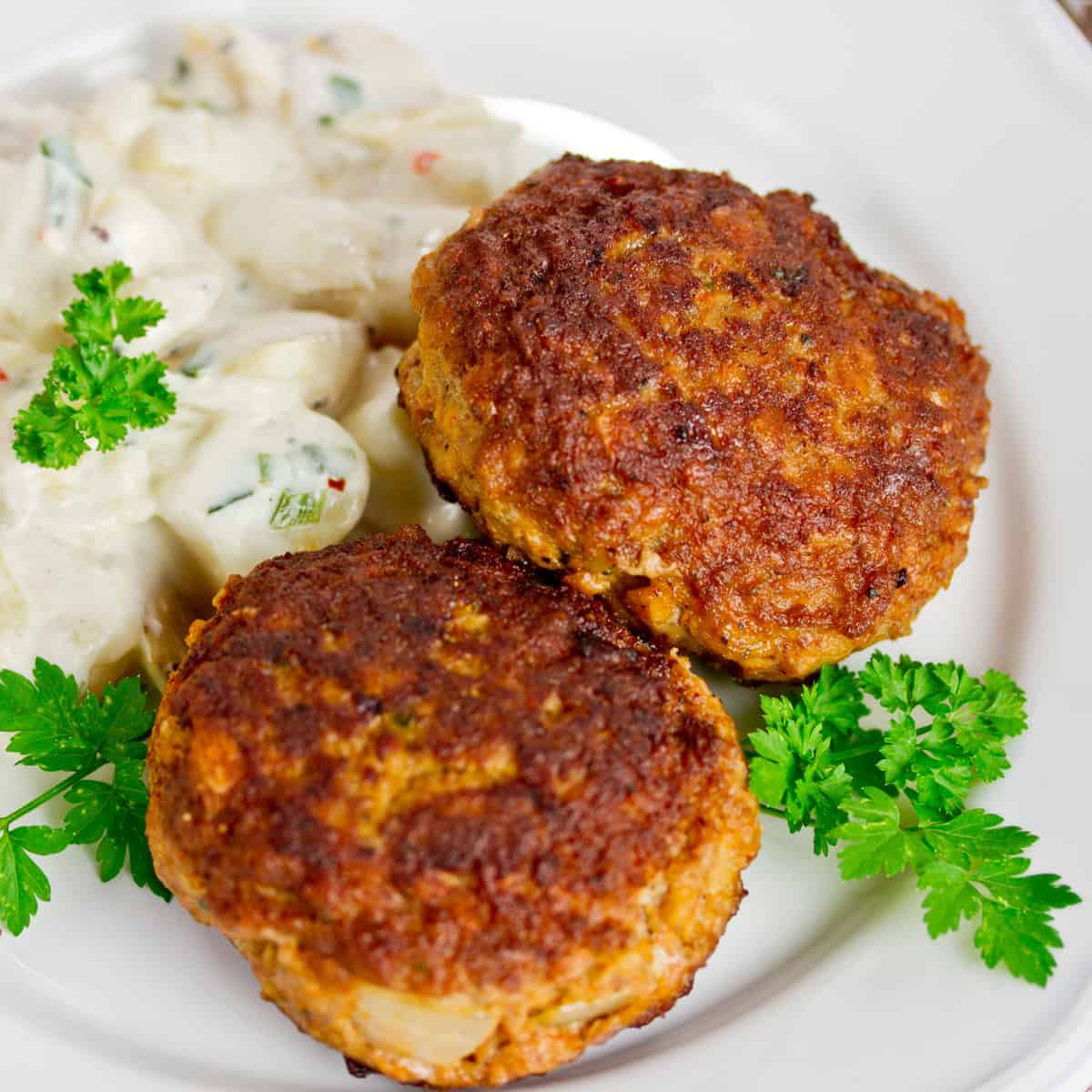
For more traditional German recipes be sure to try my:
- Rouladen
- Sauerbraten
- Maultaschen
- Schnitzel
- Jägerschnitzel
- Schweinshaxe
- Semmelknödel
- German Potato Dumplings
- Königsberger Klopse
- Zwiebelkuchen
- German Sauerkraut Soup
- Käsespätzle
- German Bread (Vollkornbrot)
- Bratwurst
- Currywurst
- Rotkohl
- Sauerkraut
Save This Recipe
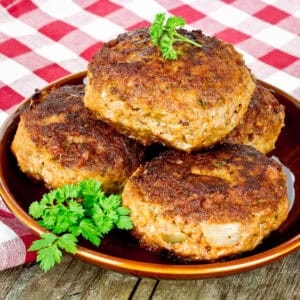
Traditional Frikadellen (German Meatballs)
Ingredients
- 1/2 pound ground beef , 80% recommended for moist Frikadellen; no leaner than 92%
- 1/2 pound ground pork
- 1 medium yellow onion , very finely chopped
- 2 slices slightly stale white bread (about 2 oz or 50 g) (can also use fresh croutons and let them sit out a day); For gluten free use GF bread
- 1/4 cup warm water or milk
- 1 large egg
- 1 clove garlic , minced
- 1/4 cup chopped fresh parsley
- 1 1/2 teaspoons salt
- 3/4 teaspoon freshly ground black pepper
- 1 teaspoon prepared yellow mustard
- 1 teaspoon dried marjoram
- 1 teaspoon sweet Hungarian paprika
- 1/2 teaspoon ground ginger
- 1/4 teaspoon ground mace
- 1/4 teaspoon ground coriander
- 1/8 teaspoon ground cardamom
- 3 tablespoons olive oil
- 1 tablespoon butter
Instructions
- Break the bread up into small pieces, place them in a small bowl and pour water/milk over them and let them soak for 15 minutes while you're preparing the other ingredients. Squeeze out any excess liquid.
- Heat some oil or butter in a frying and saute the onions until soft and translucent, 5-7 minutes. Add the garlic and cook for another minute.
- Place all of the ingredients (except for the olive oil and butter) in a large bowl along with the onion mixture and the soaked bread. Use your hands to thoroughly knead the mixture until well blended and the meat is smooth. The more you knead it, the better the results. Form the meat mixture into balls according to desired size and slightly flatten them. Cover and chill the patties in the fridge for at least 30 minutes.
- Heat the olive oil and butter in a frying pan. Once hot add the Frikadellen / Frikadeller and fry on both sides on higher heat until nicely browned, then lower the heat and continue to fry over medium heat until cooked through according to desired doneness. Traditionally served with potato salad or a crusty bread roll slathered with mustard. See blog post for other serving ideas.
Notes
Nutrition
Originally published on The Daring Gourmet September 16, 2019



















Hello – I usually make the Austrian version we call Fleischlaberln. Will definitely try your recipe though. Question: under nutritional values you mention 483 calories. That’s good to know but must also know what [patty] weight this applies to and whether raw or cooked.
Cheers
Karl
Hi Karl, this calls for 1 pound of meat and makes 4 servings. So that will be roughly 450 grams divided by 4 = 112 grams per serving/patty, give or take a few grams.
Loved this recipe. I didn’t have Hungarian paprika so used regular; used nutmeg as substitute for mace; and equal parts of cinnamon & nutmeg for cardamon. Definitely a keeper!
Fantastic, Peggy, I’m so glad you enjoyed it, thank you!
I am from Indonesia. Frikadel with additional variations of names (lots of Indonesians could not pronounce the f-sound, even now some are confused about the f-sound; my name used to be Fanny, so many used to call me Penny, and I got confused what my name was. Even now some people think that words with the p-sound should be changed with f, which is funny. e.g. Resep (recipe), they thought it should be resef—etc. Anyway, so frikadel is sometimes called bregedel, or perkedel, or frikadel, but they are the same thing. In Indonesia instead of bread, frikadel is made with steamed, or boiled, or fried potatoes. For seasoning it is the very popular trinity: salt, pepper, and nutmeg. And shallots and garlic, and some scallions, Asian celery. Some do not use shallots, garlic. Just scallions, some do not use any of the 3 ingredients, just the salt, pepper, and nutmeg. I found one recipe in English, many are in Indonesian.
https://thedomesticman.com/2015/01/27/indonesian-meat-and-potato-fritters-perkedel/
and another one:
https://dailycookingquest.com/perkedel-kentang.html
These are very popular, are always used as part of the many side dishes for festive occasions for the yellow rice dish.
https://www.instructables.com/id/Artistic-Indonesian-Rice-Cone-Nasi-Tumpeng/
In our family, we don’t eat pork but I was wondering if it would be worth trying with ground chicken and beef. I know it wouldn’t be authentic but I’m thinking it would still be a tasty alternative to hamburgers. What do you think?
Absolutely, Michele, happy cooking!
Could these be made in an air fryer?
Thanks for the recipe. My Mom makes with egg instead of milk. I am going to try ur recipe.
Pauline
Awesome, just made them tonight. Made an onion gravy with homemade mushroom soup and sour cream. The wife doesn’t like hamburger or meatballs. But loved the German version…hhahh. now I’m all set!
Fantastic, Scott, well done!!
My parents are Flemish and have made these but more simple and the side dish would be prunes and cherries Christmas tradition
I grew up eating these, a great snack food. My mom just s from Berlin and we call them Buletten.
I have heard of these, (I am 88 years young) my Grandmother and my Mother made these when we lived on the farm in Ohio. Thanks Kimberly for sharing your recipe ( my Grandmothers and Mothers too) with the the world, they will love it!
Thank you, Bernie! :)
i grew up with them but had forgotten about them. But , without trying, I have made Patties very close like the recipe suggested probably I remember my mother making them :-).
What do you think about other types of bread instead of white, like rye, wheat or pumpernickel?
Hi Tanja, sure, that’s not set in stone. White bread is what’s most commonly used but you can certainly use whole grain.
My x-mother in law was from Denmark and used to make these. They were delicious. I never learned how to make them but remembered that they were made from ground beef and pork. I’m anxious to try and make it.
Is the prepared yellow mustard the English Colmans type mustard of the American yellow mustard?
Hi Anthony, in Germany you would use a German yellow mustard. If you don’t have access to that, use whichever yellow mustard you like.
I´m german, live in Germany and this is similar to my moms recipe for our “Fleischküchle” , in Bayern (Bavaria) they say Fleischpflanzerl…. You have to eat them with potatoe salad. Great recipe.
Greetings from Stuttgart
Ute
Greetings to Stuttgart, Ute! I welcome anything that gives me an excuse to eat potato salad :)
I used to buy these homemade from a German deli and they were soooo good. I can’t wait to make them. It’s been years since I had them.
I hope you enjoy them, Carol, happy cooking! :)